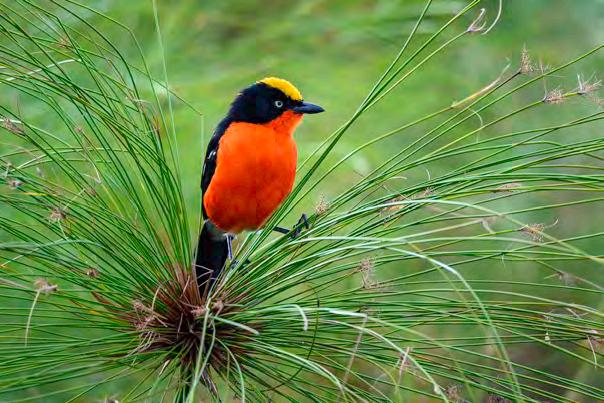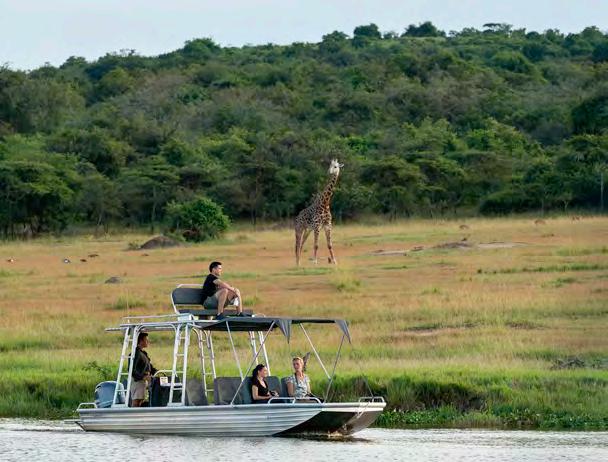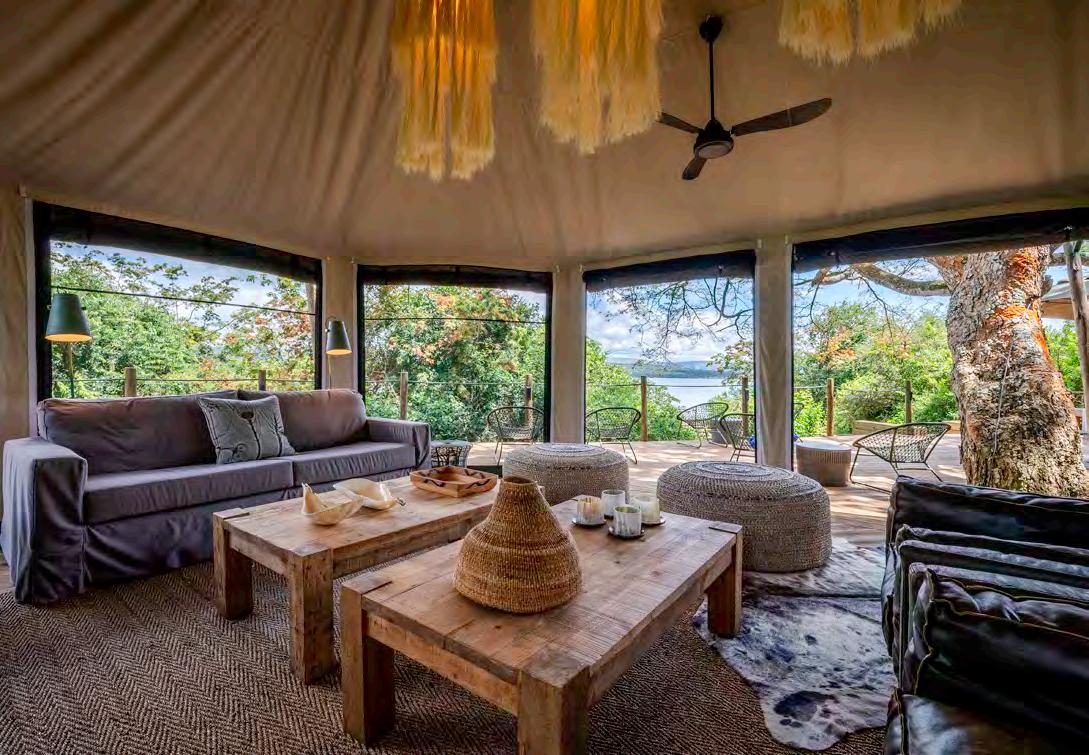
8 minute read
TRAVEL
Remarkable Rwanda
Conservation push sees parks and tourism grow
Advertisement
WORDS SUZANNE MORPHET
YOUR BODY ove L
Renew your natural beauty at
Eliminate stubborn fat with Coolsculpting


we’re getting closer,” says my guide, holding up a radio antenna in one hand and a receiver in the other. “It’s quite strong.”
We’re looking and listening for M-7, a collared male lion who’s out there somewhere in the fading light of a September afternoon in one of the oldest national parks in Africa.
A few minutes later, Hein steers our 4X4 off the dusty red ribbon of a road and we lurch over rough ground and around small shrubs.
Just over the crest of a hill we spot him. He’s lying in long grass near a warthog burrow. His tan and tautly muscled body blends in with the grass and a radio collar is barely visible under his thick mane.
He’s with his brother and they barely look up as we come to a stop a few metres away.
“They might wait for this warthog to come back,” says Hein. “They love warthog.”
The lions of Akagera National Park are just one of Rwanda’s conservation success stories in a country where “remarkable” seems to be more than just a tourism marketing slogan.
Created in 1934, the government abandoned Akagera during the genocide in 1994. When that nightmare ended, people who had fled came here in search of a new home, bringing 40,000 head of cattle with them.
Wildlife stood no chance against farmers and poachers and in 1997 the government downsized the park by two-thirds.
What remains is still some of the most scenic savannah in East Africa with high ridges, deep valleys, lakes and plains. Lions were reintroduced in 2015 and black rhinos two years later, meaning Akagera is once again a “Big Five” park.
Sizable herds of buffalo, zebra, impala and topi graze the plains, while hippos and crocodiles rule the shallow lakes and papyrus swamps, which form the largest protected wetland in central Africa. BOOK NOW | 250-743-7546 | renulaserandskin.com YOUR LOOK Located in Mill Bay, we’re here to renew your natural beauty with physician-led laser and skincare treatments that will leave you feeling more like yourself than ever. every age with physician-led laser and skincare treatments.
BOOK NOW | 250-743-7546 | renulaserandskin.com #1 Non surgical fat reduction treatment Safe and effective with no dowtime . Treatment areas include: Abdomen, chin, love handles, back bra, inner and outer thighs and more! Master Certified Specialists WESTMOUNT WEALTH GROUP WESTMOUNT WEALTH GROUP Joe Basque BA, CFP ® Investment Advisor HollisWealth ® , a division of Industrial Alliance Securities Inc. j.basque@ westmountwealth.com Matthew Evans CFP ® , CIM ® Portfolio Manager HollisWealth ® , a division of Industrial Alliance Securities Inc. m.evans@ westmountwealth.com Lorenzo Pederzani CFA, CFP ® , FCSI ® Portfolio Manager HollisWealth ® , a division of Industrial Alliance Securities Inc. l.pederzani@ westmountwealth.com The Westmount Wealth Group is a boutique practice focusing on high-level financial planning and fiduciary investment management. Our team members are financial professionals with different areas of specialization including investments, insurance, tax planning, retirement income planning and estate planning. Suite 2-668 Beach Road, Qualicum Beach 250-752-5100 | westmountwealth.com HollisWealth® is a division of Industrial Alliance Securities Inc.





The government’s strong commitment to conservation has led Botswana-based Wilderness Safaris to open a new camp here, its second in Rwanda, with exclusive rights to the diverse northern corner of the park.
“Don’t be scared,” says Anita, the manager at Magashi camp, as she shows me to my tent on a raised platform overlooking Lake Rwanyakazinga. “You’re going to hear hippos all night.”
And not just hippos, but nightjars — one of Akagera’s 500 species of birds —and bubbling kassina, a type of frog. That night I fall asleep to a strange symphony of churring and whooping, but most of all to the loudest grunts and oinks I’ve ever heard. Good night, hippos!

Rwanda is densely populated. It’s smaller than Vancouver Island but home to 12 million people, making its conservation achievements all the more impressive.
In the opposite corner of the country, Nyungwe Forest National Park teems with life: birds, butterflies and 13 species of primates, including chimps. The park also contains a spring that’s thought to be the remotest source of the Nile River.
When we arrive late one afternoon, mist is rising from the valley floor far below. The air feels wonderfully moist and cool on bare skin. A trail leads deep into the forest where we can hear the rat-atat-tat of a great blue turaco, a bird traditionally hunted for its meat and feathers.
Eventually we come to what looks like a single strand of a giant cobweb strung across the sky. It’s actually a walkway designed to give visitors a bird’s-eye view of the surrounding jungle and it was built by Vancouver-based NGO Greenheart. We linger, suspended in mid-air for many minutes, reluctant to leave this romantic landscape.
But another park is calling. Gishwati Mukura National Park near Lake Kivu will officially open as the country’s fourth sometime this year.
Sitting on the high divide between the Congo and the Nile river basins, its two montane forests total just 34 square kilometres, a tiny fraction of Nyungwe, but it will also provide important protection for wildlife, in this case golden monkeys, chimpanzees and rare birds.
Wilderness Safaris is opening a camp here too. The details are still under wraps, but the conservation-minded company negotiated
211 Craig St., Downtown Duncan | 250 748 7709 impeccablejewellery.com @impeccablejewellery special occasion | custom | repairs | watches | gold & diamond Jewellery…like no other


a 25-year concession agreement with the Rwanda Development Board to create an exclusive chimpanzee and primate trekking experience.
Speaking of primate trekking, you can’t come to Rwanda without visiting the gorillas of Volcanoes National Park. Well, you could, of course, but why would you? This is where Dian Fossey brought to the world’s attention the desperate plight of the species that shares 98 per cent of our genetic code.
Before we visit the park, we’re curious to see what the country has achieved with its admittedly pricey gorilla viewing permits. Individual permits cost $1,500 US and of that, 10 per cent goes to local improvement projects. In 2018, that totalled almost $2 million US.
In one village we tour a new hospital. At another we’re introduced to Preciosa Nyiramikam and meet her cow, bought with tourism money. Preciosa tells us she no longer worries about feeding her family. And at the Gorilla Guardians Centre in Musanze we meet reformed poachers who now get paid to be wildlife protectors.
Volcanoes National Park is part of the Virunga massif, a chain of eight volcanoes that spans Rwanda, Uganda and the Democratic Republic of the Congo. Of these, Mount Karisimbi is the highest, at 4,507 metres, and this is where my group heads.
Unlike most wildlife experiences in Africa, where you pay and take your chances, seeing gorillas here is pretty much guaranteed. Armed trackers go into the park early every morning to find each family of gorillas, then report their location to guides. It’s a way of protecting the gorillas as well as monitoring their health. But knowing we’re definitely going to meet our closest animal cousins doesn’t diminish our excitement. If anything, it increases it. How many will we see? How close will we get?
For the first hour we hike through a radiant bamboo forest. Then the path gets steep and muddy. Bamboo gives way to large African redwood with a dense understory. Finally, we leave the trail and hike through waist-high stinging nettles that live up to their name.
When we meet the armed trackers for the Susa family of gorillas we know we’ve arrived.
We’re led into a large clearing where Kurira, Susa’s dominant silverback, sits alone on the forest floor, arms wrapped around his manly chest like he’s giving himself a hug.
Then other gorillas come into view through the greenery. More silverbacks, mothers with youngsters and one with a baby. They look content, even bored, examining their fingernails or chewing a branch. They come so close that sometimes we have to move quickly to get out of their way.
When another family of gorillas suddenly shows up, near pandemonium breaks out. The Susa family — all 26 of them — gather together as if to confer, then turn and leave in single file. As they disappear into the forest it’s like watching a river of gorillas flow by.
Yes, gorillas will likely always be Rwanda’s pride and joy, and for good reason.
But it’s heartening to know this tiny country is restoring and protecting its other wildlife too. What it’s already accomplished truly is remarkable.

Talk to our Wealth Advisors. HOW DO YOU RETIRE AND STILL HAVE THE MONEY TO TOUR VINEYARDS?
WATCH VIDEO
SCAN ME










